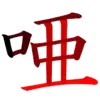唖
See also: 啞
 | ||||||||
| ||||||||
Translingual
| Stroke order | |||
|---|---|---|---|
 | |||
| Traditional | 啞 |
|---|---|
| Shinjitai (extended) |
唖 |
| Simplified | 哑 |
Han character
唖 (Kangxi radical 30, 口+7, 10 strokes, cangjie input 口一中一 (RMLM) or X口一中一 (XRMLM), composition ⿰口亜)
References
- KangXi: not present, would follow page 193, character 5
- Dai Kanwa Jiten: character 3743
- Dae Jaweon: page 413, character 13
- Hanyu Da Zidian (first edition): volume 1, page 626, character 10
- Unihan data for U+5516
Chinese
Definitions
| For pronunciation and definitions of 唖 – see 啞 (“mute; dumb; speechless; without sound; etc.”). (This character, 唖, is the former (1935–1936) ROC simplified, former (1969–1976) Singaporean simplified, and variant form of 啞.) |
Notes:
|
Japanese
| 唖 | |
| 啞 |
Kanji
唖
(uncommon “Hyōgai” kanji, shinjitai kanji, kyūjitai form 啞)
- Extended shinjitai form of 啞: mute, dumb
Readings
From Middle Chinese 啞 (MC ʔˠaX); compare Mandarin 啞/哑 (yǎ):
From Middle Chinese 啞 (MC ʔˠaH); compare Mandarin 啞/哑 (yā):
From Middle Chinese 啞 (MC ʔˠɛk̚); compare Mandarin 啞/哑 (è):
From native Japanese roots:
Usage notes
This is one of the 22 widely used extended shinjitai (簡易慣用字体 (kan'i kan'yō jitai)).
Etymology 1
| Kanji in this term |
|---|
| 唖 |
| あ Hyōgaiji |
| kan’on |
| Alternative spelling |
|---|
| 啞 (kyūjitai) |
From Middle Chinese 啞 (MC ʔˠaX).
The kan'on reading, so likely a later borrowing.
Derived terms
Korean
Hanja
唖 • (a) (hangeul 아, revised a, McCune–Reischauer a)
- This term needs a translation to English. Please help out and add a translation, then remove the text
{{rfdef}}.
This article is issued from Wiktionary. The text is licensed under Creative Commons - Attribution - Sharealike. Additional terms may apply for the media files.